Fishing in Sullivan, Missouri
The Meramec River is one of the most diversified rivers in North America. More than half of the fish in Missouri are found in the Meramec River. All three of the black bass can be fished, along with catfish and panfish.
For more information visit the Missouri Department of Conservation site for a complete fishing report. If interested in fishing areas in and near Sullivan, MO feel free to visit hookandbullet.com for a look into other fishing spots.
Additional information for fishing the Meramec River
Learn more about some of the fish you might catch:
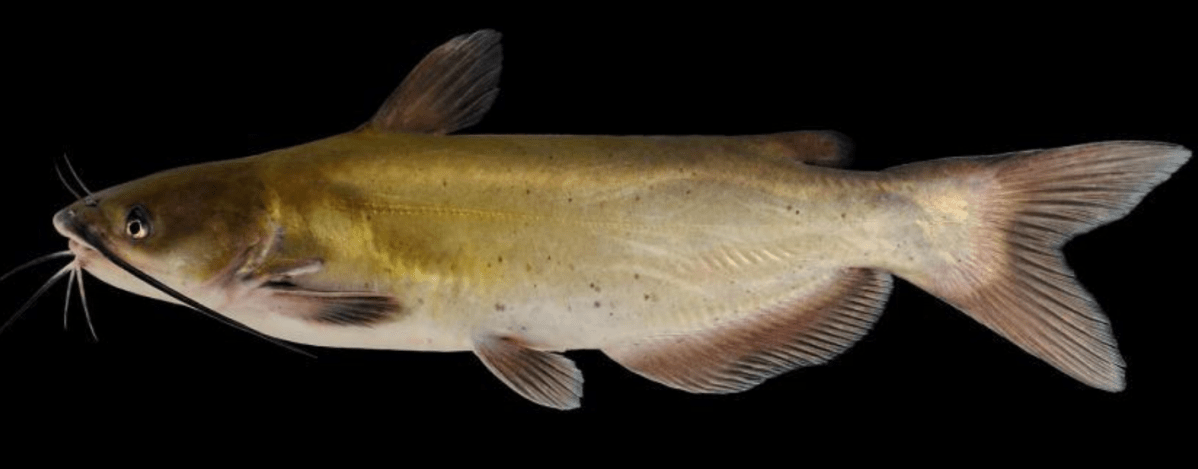
-
Scientific Name: Ictalurus punctatus
Family: Ictaluridae (bullhead catfishes) in the order Siluriformes (catfishes)
Description
Channel catfish, like our other catfish, have smooth, scaleless skin and barbels (“whiskers”) around the mouth. The channel and blue catfish both have a deeply forked tail fin, but the channel catfish can be distinguished by the following:
- It has scattered dark spots on the back and sides (the spots are often absent, however, in the smallest young and in large adults).
- The outer margin of the anal fin is rounded outward (convex) rather than straight.
- The anal fin usually has 24–29 rays (fewer than in the blue catfish).
- The base of the anal fin is relatively shorter than in the blue catfish.
- The profile of the back, from the dorsal fin forward, is gently sloping and slightly rounded outward, so the head and forward part of the body are less distinctly wedge-shaped than in the blue catfish.
The back and sides are olive brown or slate blue, usually with few to many roundish black spots. The belly is silvery white. The fins are yellowish or dusky, often with a narrow black fringe. Breeding males are a deep blue black on the back and sides, with the head swollen and knobby and the lips thickened and fleshy.
Similar species: The channel catfish is most likely to be confused with the blue catfish. The blue catfish is less widely distributed and occurs mostly in the Mississippi, Missouri, and Osage rivers. It occasionally is found in the lower reaches of those rivers’ larger tributaries, including the Grand, Gasconade, and Salt rivers. The blue catfish never has dark spots on the back and sides, has a straight-edged (not rounded) anal fin with more rays (30–35) and a relatively longer base, and has a more distinctive wedge-shaped profile. Also, it reaches a much larger size than the channel catfish.
The channel catfish sometimes mate with blue and flathead catfish, producing hybrid offspring that blend traits of both parents. Missouri’s other catfish species do not have deeply forked tail fins.
Other Common Names
Spotted Cat
Blue Cat
Fiddler
Lady Cat
Chucklehead Cat
Willow Cat
Size
Adult length: commonly 12–32 inches; weight: commonly 1–15 pounds. Specimens as large as 45 pounds are uncommon in Missouri.
Habitat & Conservation
The channel catfish is the most abundant and widely distributed large catfish in Missouri. It occurs over nearly all of the state but is especially characteristic of the Prairie region streams of north and west Missouri, the Mississippi and Missouri rivers, and the larger streams and ditches of the Bootheel lowlands. It is less abundant in the central Ozarks than elsewhere. It occurs naturally or as a result of stocking in artificial impoundments throughout the state.
The channel catfish occurs in a variety of habitats, but it is especially characteristic of large, rather turbid streams with low or moderate gradients. Adults are found in larger pools, in deep water, or around submerged logs and other cover. The young often occur in riffles or the shallower parts of pools.
During the day, adult channel catfish retire to deep water or lie about drift piles, submerged logs, or other cover. At night, they move onto riffles or into the shallows of pools to feed.
Food
Channel catfish feed at night in shallow areas of pools and on riffles, using their sensitive barbels to locate food on the bottom by taste, smell, and touch. These omnivorous fish eat fish, insects, crayfish, mollusks, and plant material. One study found insects belonging to 50 different families in the stomachs of channel catfish in the Des Moines River, indicating an extremely variable diet.
The diet varies greatly by size. Channel catfish less than 4 inches long feed almost entirely on small insects, while larger individuals eat larger food items and have a more varied diet.
Status
Game fish.
Life Cycle
The channel catfish spawns in Missouri from about the last week of May, when water temperatures reach 75 F, and continues through the third week of July. Often there are two peaks of spawning activity during this period. Prior to spawning, the male catfish selects and cleans out a nest site. Natural cavities around piles of drift, logs, or undercut banks, and the burrows of muskrats and beavers are favored nest sites. Semidarkness and seclusion are major factors in the choice of nest sites. Females normally do not participate in the selection of nest sites or in the care of the eggs or young.
The eggs are deposited in the bottom of the nest as a gelatinous mass having the appearance and consistency of a large golden yellow mound of tapioca. They hatch in about a week, and the fry remain in the nest for 7 or 8 more days. The male guards the fry only until they leave the nest.
The survival of the young during the first year of life is much lower in clear ponds than in turbid ponds, and the same probably holds true in streams. The lower survival rate in clear waters apparently is a result from greater susceptibility to predation.
Channel catfish mature when they are about 4 or 5 years old, or are about 12 to 15 inches long. The lifespan usually does not exceed 6 or 7 years, but individuals may sometimes live more then 10 years.
Human Connections
The channel catfish was established as the official Missouri state fish in 1997. It is one of the most sought-after fish in Missouri. Kansas, Iowa, Nebraska, and Tennessee have also declared the channel catfish their official state fish.
The channel catfish is one of Missouri’s most highly prized game and food fishes. As a sport fish, it has no rival in the larger prairie streams of northwest Missouri, where other game fish are scarce. It figures prominently in the creel in streams and reservoirs elsewhere in Missouri and is widely stocked in farm ponds.
Catfish farming, the commercial propagation of channel catfish for sale as live or dressed fish, is an important industry in Missouri.
Channel catfish may be caught on set lines, by jugging, or by still-fishing with rod and reel. A variety of live, cut, or prepared baits, including fish, crayfish, worms, grasshoppers, liver, shrimp, chicken and chicken entrails, blood, cheese, stinkbait, and commercial concoctions, are used to catch this fish. Occasionally it is taken on spinners, small spoons, and other artificial lures retrieved slowly near the bottom. Fishing is best near dusk and in the early part of the night, or on a rise following a heavy rain.
Ecosystem Connections
Catfish search stream bottoms, preying on creatures that will fit in their mouths, grazing on plants, and cleaning up dead animal matter.
When catfish die, they become food for other animals. And despite notably attentive parental care, their eggs and vulnerable young frequently are eaten by other animals, too.
Channel catfish are native to a wide range in North America, extending from southern Canada through the eastern United States east of the Rocky Mountains, and into northeastern Mexico. They have been introduced in many parts of the world.
The channel catfish has been called the “swimming tongue” because of the numbers of taste or taste receptors over the body surface as well as on the barbels and in the mouth and throat. These are perfect adaptations for life in murky water and nocturnal activity.
In addition to finding food by chemosensory (smell and taste) receptors, channel cats also can identify each other as individuals by smell or taste. They can detect age, size, reproductive status, territorial or fright status, and more by smell or taste alone.
When we people put our heads underwater, air in our ear canals prevents us from hearing well. But studies have found that many fish communicate with sound. Channel catfish are one of those species. They make sounds by clicking or grinding the pectoral fin bones within the pectoral girdle. Channel catfish can use this method to produce a sudden, loud sound to startle predators, causing their enemies to hesitate and allowing the catfish to escape. The sound may also alert nearby catfish of the danger. If you’re interested in learning more about how fishes use sound, do an internet search on “acoustic communication in fish.” It’s a fascinating subject.
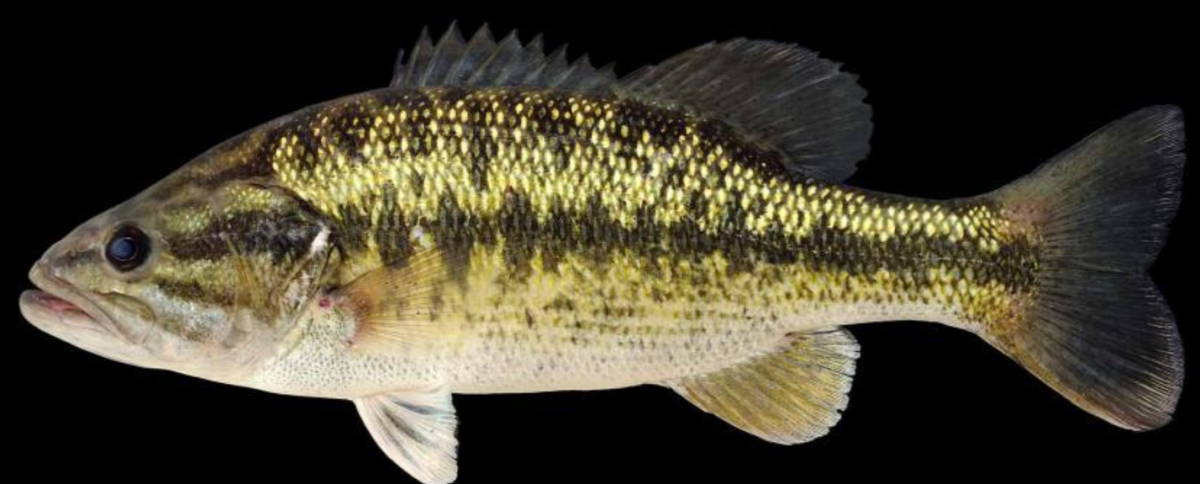
-
Scientific Name: Micropterus punctulatus
Family: Centrarchidae (sunfishes) in the order Perciformes (perch-like fishes)
Description
The spotted bass is a large, elongated fish with a large mouth. The upper jaw reaches to or only very slightly beyond the rear margin of the eye in adults. Overall color is green with a dark horizontal stripe. The upper parts are greenish with darker mottlings; the lower sides and belly are whitish with dark spots arranged in streaks. The midside has a broad, dark continuous stripe. The cheek scales are much smaller than the rest of the body scales. The tongue has a rough patch.
Similar species: The closest relatives in Missouri are the largemouth and smallmouth basses. The three are in genus Micropterus, whose members are generally called black basses.
Other Common Names
Kentucky Bass
Size
Total length: 10–17 inches; weight: ½–3½ pounds; maximum about 20 inches and 4–5 pounds.
Habitat & Conservation
This species generally inhabits permanent-flowing waters that are warmer and slightly more turbid than those where the smallmouth bass occurs. In the main channels of large rivers within its area of occurrence, it occurs almost to the exclusion of other black basses. It is abundant in most large Ozark reservoirs, where it generally is found at depths greater than those occupied by other black basses.
In cool, spring-fed streams, however, it is largely replaced by the smallmouth bass. In backwaters and floodplain lakes along streams, it is largely replaced by the largemouth bass. In the Bootheel lowlands, this is the most abundant species of black bass in flowing waters. Elsewhere in its Missouri range, it is the most abundant black bass in the larger streams. In large Ozark reservoirs, this species is more abundant than the smallmouth bass.
Although its habits are much like those of the smallmouth, the spotted bass is a more active fish. It is most active at dawn and dusk.
Food
Carnivorous, feeding on crayfish, fish, and immature aquatic insects. Bass often catch their prey by ambushing from a place of hiding. Suction created when the rather large mouth is suddenly opened helps them capture prey.
Status
Game fish.
Life Cycle
Spotted bass apparently move annually between larger rivers and reservoirs and their smaller tributaries. They appear in the smaller streams after high water in the spring and return to larger waters in the fall.
At any given locality, spotted bass begin nesting a few days later than smallmouths. In Missouri, nesting activity is most intense from mid-April to early June. Nests are similar to those of the smallmouth, and both species sometimes nest simultaneously in the same stream pools. During the first 4 years of life, the growth rate of spotted bass is slightly faster than that of the smallmouth, but it is slower after that.
Individuals can live for about 6 years.
Human Connections
The spotted bass is an important game fish in Missouri’s larger streams and reservoirs, although it is less desirable because of its smaller size. Fishing methods are similar to those for taking largemouths and smallmouths.
Ecosystems Connections
Introduced populations of spotted bass tend to replace the smallmouth through hybridization and competition.
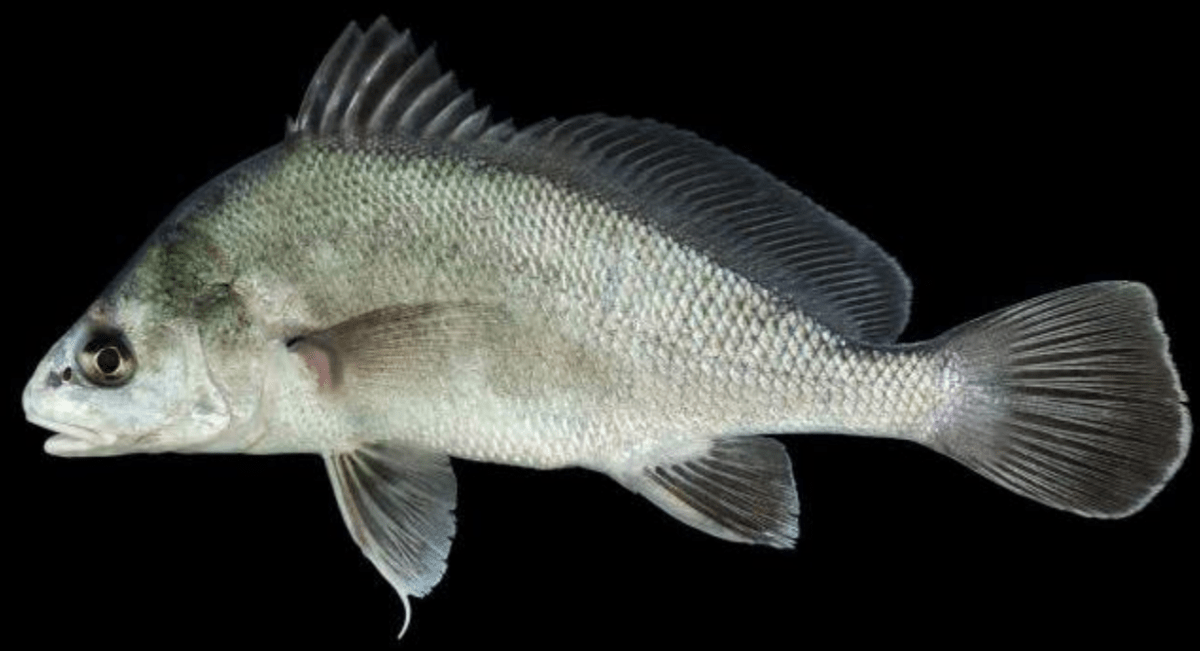
-
Scientific Name: Aplodinotus grunniens
Family: Sciaenidae (drums) in the order Perciformes (perchlike fish)
Description
The freshwater drum is a silvery, deep-bodied fish. The head and body slope upward from the snout to the dorsal fins and give the fish a distinct humpbacked appearance. The lips are milky white, and the pelvic fins are white, often tinged with orange. The dorsal fin is long and is divided into two distinct parts.
Other Common Names
Sheepshead
Sheephead
Size
Total length: 12-20 inches; weight: 12 ounces to 5 pounds; maximum weight (in Missouri) about 40 pounds.
Habitat & Conservation
Occurs in large rivers, lakes, and impoundments over most of Missouri, usually found in association with sandy or mixed mud-and-sand bottoms. Often found in depths of 30 feet in rivers with larger pools and reservoirs.
Food
Long thought to be a mollusk eater (because of its heavy “throat teeth”), this species actually eats mainly fish, crayfish, and immature aquatic insects. Microcrustaceans and zooplankton are the foods of larval drum, which can also feed on other fish fry because of their unusually large mouths and their ability to roll the ingested fry into a ball.
Status
This species is harvested both commercially and as a sport species.
Life Cycle
Individuals can live for 13 years.
Human Connections
Various groups of Native Americans used the otoliths (ear bones) as jewelry. In the Great Lakes, especially Lake Erie, people walk the beaches looking to collect these otoliths, which they call “lucky stones.”
Ecosystems Connections
We humans often don’t realize that there are sounds underwater, and animals making them. Drum fish (members of the Sciaenidae, the drum family) get their name from the grunting, croaking, or “drumming” sound they make using specialized muscles associated with the swim bladder. In this species, the sound is thought to be used in mating activities.
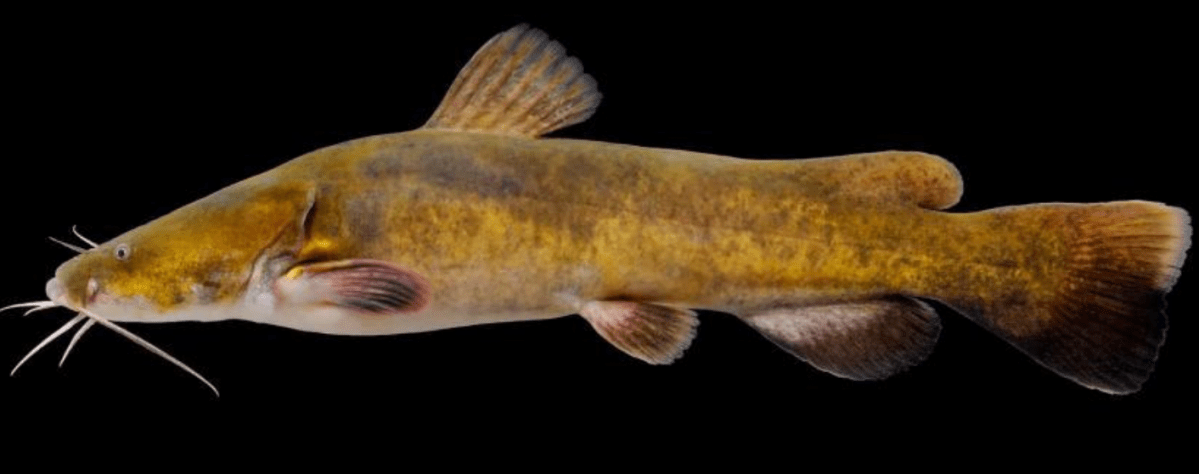
-
Scientific Name: Pylodictis olivaris
Family: Ictaluridae (bullhead catfishes) in the order Siluriformes (catfishes)
Description
The flathead catfish has a broad, flattened head with small eyes on top. The lower jaw projects beyond the upper jaw. It occurs in most of the large streams of Missouri, preferring places with a slow current.
Missouri catfishes have smooth, scaleless skin and barbels (“whiskers”) around the mouth. The flathead catfish is distinguished by its broad, flattened head with small eyes on top, and the lower jaw projecting beyond the upper jaw. The tail fin is mostly squared off, with a slight notch (it is not deeply forked), and the anal fin is rounded, with 14–17 rays. The body is often strongly mottled with brown or black.
The back and sides are pale yellow to light brown or olive, mottled with dark brown or black (mottling is often poorly developed in adults from turbid water). The belly is pale yellow or creamy white. The tail fin is dark brown or black except for the upper lobe. The other fins are similar in color to nearby parts of the body. Young individuals are darker and more boldly marked than adults.
Similar species: There are 17 species of catfishes in Missouri. This is the only one with all the following characteristics:
- The adipose fin is a free lobe, widely separate from the tail fin.
- The tail fin is not forked.
- The lower jaw projects far beyond the upper jaw (except in the smallest young).
- The upper tip of the tail fin is lighter in color than the rest of the fin.
- The pad of teeth in the upper jaw has a backward extension on each side.
Other Common Names:
Shovelhead Cat
Yellow Cat
Mud Cat
Goujon Appaluchion
Johnnie Cat
Size
Adult length: commonly 15–45 inches; width: 1–45 pounds. Maximum is about 100 pounds.
Habitat & Conservation
The flathead catfish occurs in most of the large streams of Missouri. It is one of the most abundant of the larger catfishes in the Missouri and Mississippi rivers, in their principal tributaries of the prairie region of northern Missouri, and in the larger streams and ditches of the Bootheel lowlands. In the Ozarks, it is largely restricted to reservoirs and the downstream sections of the largest streams.
It inhabits a variety of stream types but avoids those with high gradients or intermittent flow. It is never found in headwater creeks. It achieves its greatest abundance in large rivers.
The young are often found among rocks on riffles, occupying much the same habitat as the stonecat and other riffle-dwelling madtoms. Adults occur in pools, near submerged logs, piles of drift, or other cover.
The flathead is a solitary species, and a single unit of cover, such as a drift pile, will usually yield only one or at most two or three adults. Each individual normally has a favorite resting place where it can be counted on to be each day unless disturbed.
Adults move at night from deeper water or cover to riffles and the shallows of pools to feed. The young remain continuously on the riffles but are active only at night.
Food
Flathead catfish forage at night. Smaller flatheads, less than 4 inches in length, eat insect larvae; adults prefer fish and crayfish and other crustaceans. Unlike channel catfish, they are not scavengers and rarely eat dead or decaying material.
Life Cycle
Flathead catfish spawn in late spring or early summer (late June and July), somewhat later than the channel catfish. A saucer-shaped depression is excavated by one or both parents in a natural cavity or near a large submerged object. The eggs are laid in a compact, golden yellow mass that may contain 100,000 eggs or more. The parent fish agitates the eggs continuously by fin movements during development to provide oxygen and flush away silt.
After the young have hatched and begun to swim, they remain for several days in a compact school near the nest. Soon, they disperse and take up a solitary life. The male guards the fry for about 7 days after hatching.
Flathead catfish become mature when 4 or 5 years old, or when they’re about 18 inches long. Among Missouri catfishes, only the blue catfish grows larger than the flathead.
Human Connections
The flathead catfish is an important commercial and sport fish along the Missouri and Mississippi rivers and is commonly taken by sport fishers in large streams and reservoirs over most of Missouri.
Before the commercial fishery for catfish was closed in the Missouri River, the harvest of this species by Missouri’s commercial fisherman was more than 208,000 pounds.
Sport fishers probably take more flatheads on trot lines than by any other method, but many are caught by jugging or by still-fishing with rod and reel. Methods are similar to those for taking channel catfish except that only live or freshly killed baits are effective.
In old-time Ozark dialect, flathead catfish were called “granny cats.”
Ecosystems Connections
Flathead catfish are aquatic predators, but that doesn’t mean they don’t get preyed upon themselves. The young of even the largest species of fish are vulnerable to predation, and so are the eggs. This is one reason why catfish, and many other fish, have highly developed parental care, guarding their eggs and fry. Their nocturnal lifestyle is another defense against predation.
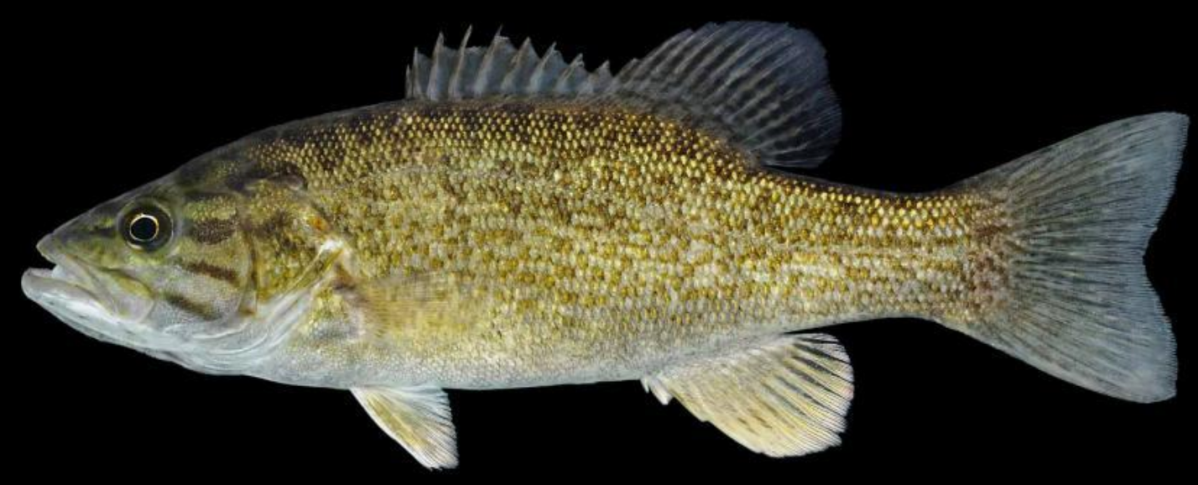
-
Scientific Name: Micropterus dolomieu
Family: Centrarchidae (sunfishes) in the order Perciformes (perch-like fishes)
Description
The smallmouth bass is a large, elongated fish with a moderately large mouth. The cheek scales are much smaller than the rest of the body scales. The back and sides are greenish brown, with faint dark mottling and bars; the belly is whitish, overlain with dusky pigment. There is no dark horizontal stripe, and it lacks rows of dark spots. In adults, the upper jaw reaches to about the rear margin of the eye. The tongue usually has a rough patch. The two dorsal fins are connected.
Similar species: The smallmouth bass is most closely related to the largemouth and spotted basses.
Other Common Names
Brown Bass
Brownie
Bronzeback
Size
Total length: 10 to 20 inches; weight 1/2 to 4 pounds; maximum about 22 inches long and 6 pounds.
Habitat & Conservation
Found predominantly in cool, clear Ozark streams and large reservoirs in the Ozarks. Found sparingly in the upper Mississippi River and its principal prairie tributaries that have clear water and permanent flow. Thrives in clear streams, with silt-free rock or gravel bottoms, near riffles but not in the main current. Although mostly found in streams in Missouri, it can be found in natural lakes and ponds in the northern parts of its North American range. Most active at dawn and dusk.
Food
Carnivorous, feeding on fish, crayfish, and large aquatic insects. When actively foraging for minnows and other prey, smallmouth bass commonly prowl the shoreline in quite shallow water.
The first foods of smallmouth fry include midge larvae and microcrustaceans. Fry less than an inch long are already capable of eating small fish.
An interesting habit of smallmouth bass is to follow a large turtle or sucker as it digs or roots in the bottom, pouncing on any insects or crayfish that are disturbed by this activity.
Status
This is the most sought-after sport fish in the clear, cool streams of the central Ozarks. In recent years it has become increasingly abundant and important in the sport fishery of Table Rock Reservoir and Stockton Lake.
Populations have declined in the Moreau River drainage partly because of hybridization with an introduced population of the closely related spotted bass.
Life Cycle
Smallmouth bass spawn from early or mid-April (when the water temperature exceeds 60 F) and continues well into June or even July. Peak spawning activity is in May. Smallmouth bass spawn in quiet water near shore, or downstream from a boulder or other obstruction that breaks the force of the current. Typically, nests are located where there is no perceptible current, not far from cover or deeper water to which the male retreats when frightened.
The male smallmouth fans out a nest with powerful sweeping motions of his tail fin, in typical sunfish fashion. The nest is swept clean of silt, sand, and fine gravel, leaving a saucer-shaped depression with a diameter about twice the length of the male. The nest is floored by coarse gravel and rock.
Females enter the nest only to spawn. The male does not assume special breeding colors, and most of the time the sexes are difficult to distinguish. However, when entering the nest, the female develops a strongly barred and blotched pattern, while the male retains a uniform coloration. Spawning occurs during a period of 20 or 30 minutes, until the full complement of eggs is deposited. Sometimes more than one female enters the nest at the same time, and a single nest may contain the eggs of several females.
Nests contain about 2,500 eggs on average, but sometimes 10,000 eggs are present. They hatch in 2 or 3 days. The fry remain at the nest and continue their growth and development for about 12 more days; soon after, they disperse.The male guards the nest and fry until they are gone.
As many as 80,000 bass fry are produced in a single mile of Ozark stream, but these may be reduced to less than 100 by early September of the first year of life. They are most vulnerable when they are small; as they grow larger, their potential predators become more limited. Individuals can live up to about 10 to 12 years.
Human Connections
A popular sport fish of the Ozarks. The most effective live baits include minnows, crayfish, and hellgrammites. Spinning and casting with the same types of lures used for taking largemouth bass also work. Some people consider fly fishing to be the ultimate sporting method for catching “brownies.”
One of the craft breweries based in Missouri’s Ozarks named its “Bronzeback” beer to celebrate this favorite sport fish.
Ecosystems Connections
In the Ozarks, the smallmouth bass is the dominant species of large, predatory fish in most streams. It is the ecological replacement, or counterpart, for the spotted bass and the largemouth bass in the clear, cool, permanent-flowing streams of the Ozarks.
The nests of smallmouth bass are centers of activity for other fishes. Longear sunfish, for example, commonly gather around smallmouth nests and rush in to feed greedily on eggs or fry if the guardian male smallmouth is distracted or frightened away.
Shortly after hatching, orangethroat darter fry sometimes inhabit the nests of smallmouth bass. Many bass nests literally swarm with darters. It is believed that the young orangethroats benefit from the protection of the male bass guarding its nest; the full-grown bass will not feed on such “small fry.” There may also be more of the preferred prey for the orangethroat fry in these locations, too.
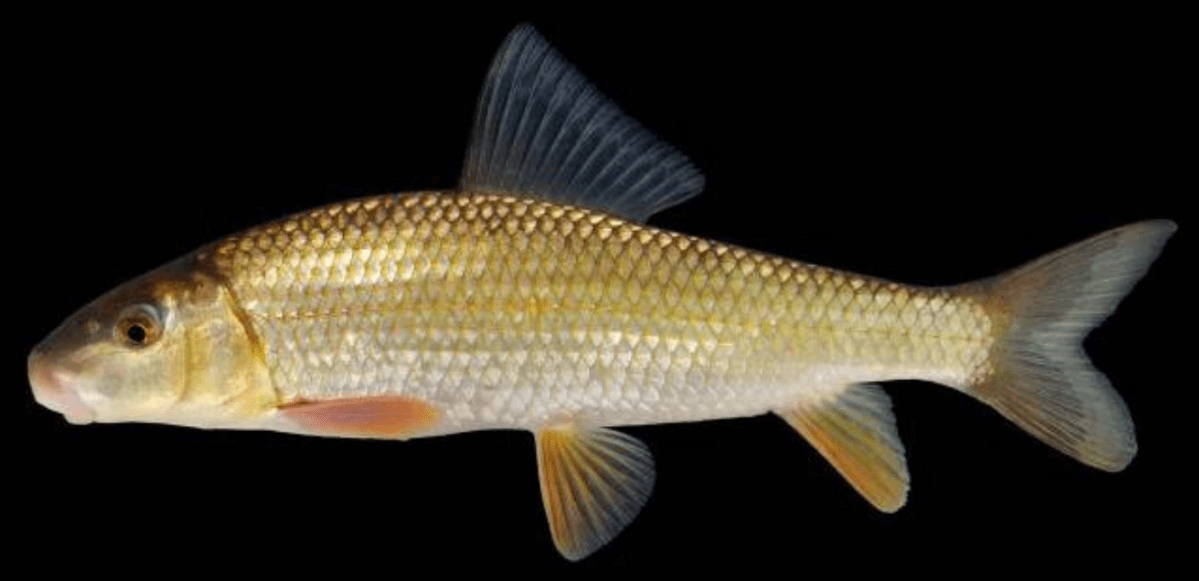
-
Scientific Name: Moxostoma erythrurum
Family: Catostomidae (suckers) in the order Cypriniformes (carps, minnows, and loaches)
Description
The golden redhorse is a smaller-bodied sucker with large scales and a short dorsal fin. The lower lip is broken into parallel folds, and the rear margin of the lower lip forms a V-shaped angle.
Other Common Names
Yellow Sucker
Golden Sucker
Size
Total length: 9 to 15 inches; maximum about 17 inches.
Habitat & Conservation
Occurs in pools and riffles of moderately clear permanent streams with moderate siltation, moderate current, and gravel or rocky bottoms. The most commonly gigged sucker in Missouri.
Food
Forages on the bottoms of pools for various invertebrates, such as larval midges, mayflies, and caddisflies.
Status
Nongame.
Life Cycle
Individuals can live for 11 years or more.
Human Connections
Much of the gigging and snagging harvest of redhorse suckers in Ozark streams is of this species and its relative the black redhorse (“white sucker”). Also caught on hook and line. Scored and deep-fried, the Y bones disappear; the firm, sweet flesh is delicious.
Ecosystems Connections
We often don’t think about the interconnections between aquatic food chains and terrestrial ones, but when bottom-feeding redhorses limit (or “check”) the populations of aquatic larval midges, mayflies, and caddisflies, they influence how many of these insects live to become flying, terrestrial adults.
